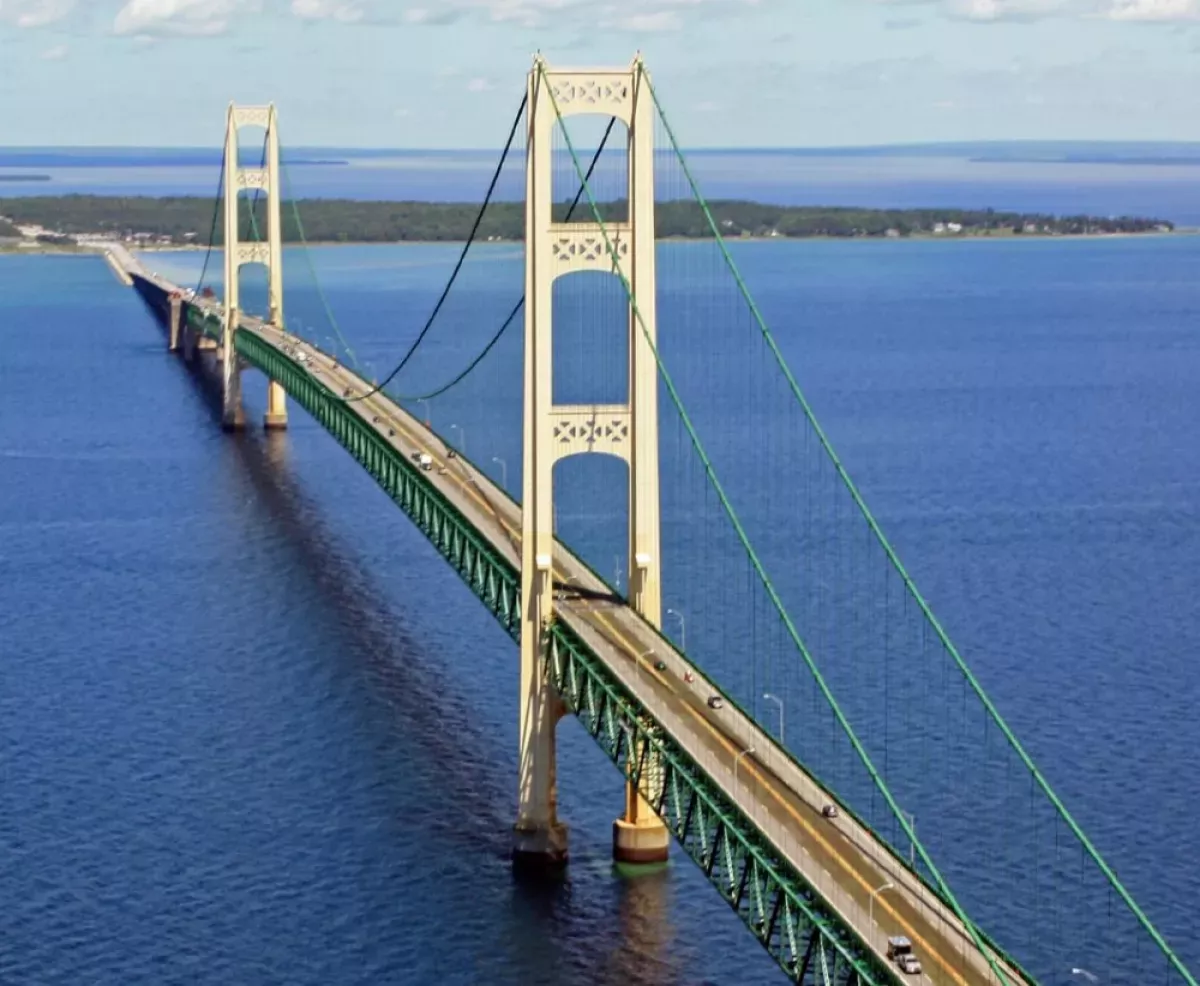The Mackinac Bridge, opened in 1957, is a suspension bridge spanning the Straits of Mackinac, connecting Michigan's Upper and Lower Peninsulas. At 26,372 feet, it's the world's 27th-longest main span and the longest suspension bridge between anchorages in the Western Hemisphere. Part of Interstate 75, it carries the Great Lakes Circle Tour and is a segment of the U.S. North Country National Scenic Trail. The bridge links St. Ignace to the north with Mackinaw City to the south.
1920: Proposal for Floating Tunnel
In 1920, the Michigan state highway commissioner proposed the construction of a floating tunnel across the Straits of Mackinac. C. E. Fowler of New York City suggested a series of causeways and bridges using intermediate islands.
1923: Initiation of Automobile Ferry Service
In 1923, Michigan initiated an automobile ferry service between Mackinaw City and St. Ignace. The service grew to operate nine ferry boats, handling up to 9,000 vehicles per day, with traffic backups stretching as long as 16 miles.
1923: Legislature Orders Ferry Service
In 1923, the Michigan state legislature ordered the State Highway Department to establish a ferry service across the Straits of Mackinac. This move significantly increased the call for a bridge as ferry usage grew each year.
1928: Feasibility Study for Bridge
By 1928, ferry service was so popular and costly that Governor Fred W. Green ordered a feasibility study for a bridge. The estimated cost was $30 million, equivalent to $421 million in 2023.
1934: Creation of Mackinac Straits Bridge Authority
In 1934, the Michigan Legislature created the Mackinac Straits Bridge Authority to explore methods for constructing and funding the proposed bridge. Despite endorsements, federal funds were not appropriated.
1936: Route Selection and Geological Study
Between 1936 and 1940, the Mackinac Straits Bridge Authority selected a route for the bridge and conducted detailed geological studies.
1939: Construction of Northern Shore Causeway
In 1939, construction began on a 4,000-foot concrete causeway extending from the northern shore of the Straits of Mackinac as part of the preliminary plans for the bridge.
1940: Completion of Geological Studies
By 1940, detailed geological studies of the proposed bridge route were completed.
1940: Tacoma Narrows Bridge Failure Influences Mackinac Bridge Design
In 1940, the failure of the Tacoma Narrows Bridge due to instability in high winds influenced the design of the Mackinac Bridge. To prevent similar issues, the Mackinac Bridge incorporated deep stiffening trusses and an open-grid roadway, enhancing stability in winds up to 150 miles per hour (240 km/h).
1941: Completion of Northern Shore Causeway
By 1941, the 4,000-foot concrete causeway extending from the northern shore of the Straits of Mackinac was completed.
1947: Abolishment of Mackinac Straits Bridge Authority
In 1947, the Michigan Legislature abolished the Mackinac Straits Bridge Authority but created a new Mackinac Bridge Authority three years later in 1950.
June 1950: Retention of Engineers for Bridge Project
In June 1950, engineers were retained for the Mackinac Bridge project. Ferry queues were so long that it took five hours for cars to reach St. Ignace from Mackinaw City, highlighting the need for the bridge.
January 1951: Engineers' Report
In January 1951, a report by engineers led to legislative authorization for the sale of bonds to finance the Mackinac Bridge.
April 30, 1952: Authorization of Bond Sale
On April 30, 1952, the Michigan state legislature authorized the sale of $85 million in bonds for the construction of the Mackinac Bridge. The project faced delays due to a weak bond market in 1953.
January 1953: Appointment of Design Engineer
In January 1953, David B. Steinman was appointed as the design engineer for the Mackinac Bridge. By the end of the year, estimates and contracts were finalized.
1953: Bond Sale Delays
In 1953, a weak bond market forced a delay of more than a year before the bonds for the Mackinac Bridge construction could be issued.
May 7, 1954: Start of Construction
Construction of the Mackinac Bridge began on May 7, 1954, under two major contracts. The project was estimated to cost $95 million and be completed by November 1, 1956.
November 1, 1956: Estimated Completion Date
The Mackinac Bridge was estimated to be completed by November 1, 1956, with a total cost of $95 million.
November 1, 1957: Formal Dedication of the Mackinac Bridge
On November 1, 1957, the Mackinac Bridge was formally dedicated as the world's longest suspension bridge between anchorages. This event marked the end of ferry services that had connected Michigan's peninsulas for decades.
November 1957: Celebration of Bridge Opening
In November 1957, the Mackinac Bridge was officially opened, connecting the peninsulas of Michigan. The bridge's opening was celebrated with the release of a commemorative 3¢ stamp by the United States Postal Service.
1957: Completion of the Mackinac Bridge
In 1957, after decades of envisioning and planning since the 1880s, the Mackinac Bridge was completed. Designed by engineer David B. Steinman, it has become an iconic symbol of Michigan.
June 25, 1958: Formal Dedication of Mackinac Bridge
The Mackinac Bridge was formally dedicated on June 25, 1958. The bridge construction, staged using the 1939-1941 causeway, took three and a half years and cost $100 million.
1958: First Mackinac Bridge Walk
The first Mackinac Bridge Walk was held in 1958 during the bridge's dedication ceremony, led by Governor G. Mennen Williams. This event marked the beginning of an annual tradition allowing pedestrians to walk across the bridge.
April 24, 1959: B-47 Stratojet Flies Under Bridge
On April 24, 1959, Captain John S. Lappo flew a Boeing B-47 Stratojet under the Mackinac Bridge. Following this daring maneuver, Lappo faced a general court-martial and was grounded for life.
1959: Bridge Walk Moved to Labor Day
In 1959, the Mackinac Bridge Walk was moved to Labor Day, becoming an annual event where thousands of people, traditionally led by the governor of Michigan, walk the five-mile span from St. Ignace to Mackinaw City.
November 1960: US 27 Removed from Mackinac Bridge
In November 1960, sections of the I-75 freeway opened from Indian River to Mackinaw City, leading to the removal of the US 27 designation from the Mackinac Bridge. The bridge became one of three tolled segments of I-75, with current tolls set at $4.00 for automobiles and $5.00 per axle for trucks.
1964: Bridge Walk Direction Change
Before 1964, participants of the Mackinac Bridge Walk walked from Mackinaw City to St. Ignace. After this date, the direction was reversed, with walkers starting in St. Ignace and heading to Mackinaw City.
September 10, 1978: Plane Crash into Bridge Suspension Cables
On September 10, 1978, a small private plane crashed into the Mackinac Bridge's suspension cables in heavy fog, killing three United States Marine Corps Reserve officers. The crash resulted in the plane's wings being torn off before it plunged into the Straits of Mackinac.
August 7, 1997: Worker's Fatal Fall from Bridge
On August 7, 1997, Daniel Doyle, a worker on the Mackinac Bridge, fell 60 to 70 feet from scaffolding into the Straits of Mackinac. Despite surviving the fall, he succumbed to the cold water temperatures. His body was recovered the next day.
1997: Documentary 'Building the Mighty Mac'
In 1997, Hollywood filmmaker Mark Howell produced a feature-length documentary titled 'Building the Mighty Mac,' which aired on PBS. The film included interviews with key individuals involved in the bridge's construction and featured restored 16mm color footage.
June 25, 1998: 100 Millionth Crossing
On June 25, 1998, exactly 40 years after its dedication, the Mackinac Bridge achieved its 100 millionth crossing.
1999: Long-term Bridge Painting Project Begins
A long-term painting project for the Mackinac Bridge began in 1999, expected to take 20 years due to the need for careful removal and disposal of lead-based paint. The continuous painting process ensures the bridge's maintenance and longevity.
2003: Mackinac Bridge on Modern Marvels
In 2003, the history and construction of the Mackinac Bridge were featured in an episode of the History Channel TV show 'Modern Marvels,' highlighting the bridge's engineering significance.
May 2007: Filming of Dirty Jobs Episode
In May 2007, the crew of the Discovery Channel TV show 'Dirty Jobs,' including host Mike Rowe, spent several days filming an episode featuring the Mackinac Bridge and its maintenance crew.
July 19, 2007: Detroit Science Center Unveils Bridge Model
On July 19, 2007, the Detroit Science Center revealed an 80-foot-long scale model of the Mackinac Bridge as part of the bridge's 50th anniversary celebration. Sherwin-Williams provided authentic bridge-colored paint for the exhibit.
August 7, 2007: Dirty Jobs Features Mackinac Bridge
On August 7, 2007, the Discovery Channel TV show 'Dirty Jobs' featured the Mackinac Bridge and its maintenance crew. Host Mike Rowe and his team spent several days in May 2007 filming the episode.
November 1, 2007: 50th Anniversary Celebration
The 50th anniversary of the Mackinac Bridge's opening was celebrated on November 1, 2007, with a ceremony hosted by the Mackinac Bridge Authority.
2007: Toll Increase to Fund Renovation Program
In 2007, the Mackinac Bridge Authority raised the tolls to fund a $300 million renovation program, which included the complete replacement of the bridge deck. This increase was necessary to maintain and improve the bridge's infrastructure.
2007: MDOT Features Bridge on Highway Map
In 2007, the Michigan Department of Transportation (MDOT) celebrated the Mackinac Bridge's 50th anniversary by featuring it on the cover of the state highway map, recognizing its importance as a key transportation link.
September 6, 2009: 150 Millionth Vehicle Crossing
On September 6, 2009, the Mackinac Bridge celebrated its 150 millionth vehicle crossing, marking a significant milestone in the bridge's history and highlighting its importance as a major transportation route.
2010: Designation as Historic Landmark
In 2010, the Mackinac Bridge was designated as a National Historic Civil Engineering Landmark by the American Society of Civil Engineers.
2010: USPS Releases Priority Mail Stamp
On February 3, 2010, the USPS released a $4.90 priority mail stamp featuring the Mackinac Bridge. The stamp showcased a 'seagull's-eye view' of the landmark, with artwork created by Dan Cosgrove from panoramic photographs.
December 31, 2012: Most Recent Confirmed Suicide from Bridge
On December 31, 2012, the most recent confirmed suicide occurred when an individual jumped from the Mackinac Bridge. Suicides from the bridge have been rare, with roughly a dozen cases by 2013.
2013: Record of Suicides from Mackinac Bridge
By 2013, there had been roughly a dozen suicides from the Mackinac Bridge, highlighting the rarity of such incidents due to restricted pedestrian access except during the annual bridge walk.
2017: Change in Bicycle and Pedestrian Access Policy
In 2017, the policy allowing riders of two annual bicycle tours to cross the Mackinac Bridge was discontinued. The bridge remained inaccessible to pedestrians and bicycles, with a program offered to transport bicycles.
2017: Bridge Closure for Annual Walk
In 2017, the policy for the Mackinac Bridge Walk was changed to close the entire bridge to public vehicle traffic during the event. Prior to this, two lanes remained open for vehicles.
2018: Bridge Walk Transport Changes
Until 2018, local school buses transported walkers from Mackinaw City to St. Ignace for the Mackinac Bridge Walk. This change reflected logistical updates to support the annual event.
2023: Cost Equivalency
In 2023, the authorized bond sale of $85 million in 1952 was equivalent to $783 million, highlighting the financial scale of the Mackinac Bridge project.
Mentioned in this timeline

The Boeing Company is a multinational corporation and one of...

Detroit Michigan's most populous city sits on the Detroit River...
Michigan is a peninsular state in the Great Lakes region...

September is the ninth month of the year in the...
The foot is a crucial anatomical structure present in numerous...
Trending

7 months ago George Wendt, 'Cheers' Star, Remembered Fondly After Death; Sudeikis Shares Memory

2 months ago Mecosta County Community Events: Grant Boosts Future Conversations This Week

Samsung Group is a South Korean multinational manufacturing conglomerate and the largest chaebol in South Korea Headquartered in Seoul the...
2 months ago Typhoon Kalmaegi Devastates Philippines: Hundreds Dead, Another Storm Threatens Hope
Big Bear Lake California is a city nestled in the San Bernardino Mountains within the San Bernardino National Forest Located...

2 months ago RBA Holds Rates Steady Amid Inflation Concerns and Economic Uncertainty: A Detailed Analysis
Popular

Stranger Things created by the Duffer Brothers is a popular...

XXXTentacion born Jahseh Dwayne Ricardo Onfroy was a controversial yet...
The Kennedy Center Honors are annual awards recognizing individuals and...
Turning Point USA TPUSA is an American nonprofit organization founded...

Bernie Sanders is a prominent American politician currently serving as...

Jupiter is the fifth and largest planet from the Sun...
